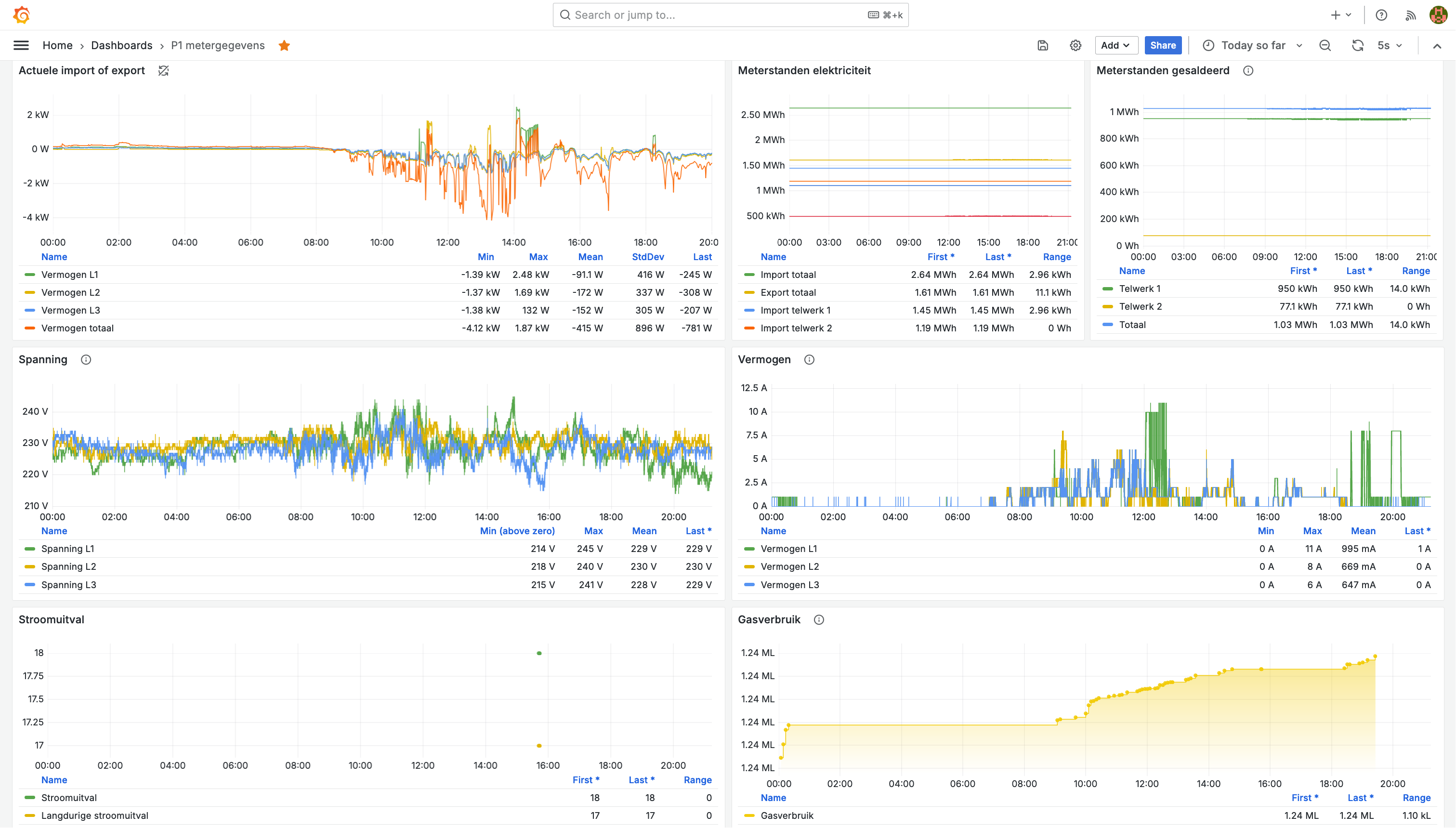| .gitea/workflows | ||
| screenshots | ||
| .gitignore | ||
| compose.timescaledb.yml | ||
| compose.yml | ||
| Dockerfile | ||
| example.env | ||
| go.mod | ||
| go.sum | ||
| LICENSE.md | ||
| main.go | ||
| README.md | ||
P1 logger
P1 logger is a tool designed to store meter data conforming to the ESMR or DSMR (European / Dutch Smart Meter Requirements) standard as efficiently as possible in a PostgreSQL database. Optionally, TimescaleDB is supported.
Background: data storage architecture
P1 logger aims to store detailed meter data as efficiently as possible. Therefore, a few design choices were made.
All metrics are stored as INT and not NUMERIC or FLOAT to optimise their storage size.
Dt1, Dt2, Rt1, Rt2, G, F and Fl are cumulative meter readings. Therefore, they function as counters that can only go up. By making them pointers to int, they can be set to 'nil' whenever a reading has not changed. This way, they are logged as NULL in the database when no change has happened, saving storage capacity. As an added benefit, this makes data retrieval, visualisation and analysis more light-weight.
Typical P1 meters update gas consumption once per minute. Not saving intermittent values theoretically saves 4 bytes per value. An average month has 43,829.0639 minutes. 4*43,829.0639 = 175,316.26 bytes = 0.18 MB
In practice, storage will be even lower, as gas is usually not consumed continuously. Therefore, a new metric won't be available for every minute.
When Tariff 1 is active, Tariff 2 isn't. When energy is being imported, it is not being returned. Therefore, only updating their values on-change should save at least 75% storage capacity requirements An average month has 2,629,743.83 seconds.
This saves at least: 2,629,743.83 seconds * 4 bytes = 10,518,975.32 bytes = 10,518.98 kB = 10.52 MB This applies both to Dt1 and Dt2 as well as Rt1 and Rt2, only one is recorded at a time. 10.52 * 3 = 31.56 MB.
In addition, many meters only update these metrics once every 10 seconds, meaning even more storage capacity is saved: 10.52 / 10 * 9 = 9,468 MB.
For D1-3 and R1-3, either Dx or Rx will be active. Therefore, their storage requirements can be sliced in half, saving 3 * 10.52 = 42.08 MB. This is different for D and R, as these contain the sum of each phase and are reported simultaneously. Not saving failures when there is no change, will save around 10.52MB per month per metric, so an additional 21.04MB.
Theoretical storage requirements for a DSMR5 meter with metrics emitted every second
| Column | Column size (bytes) | Per month (MB) | X | Total (MB) |
|---|---|---|---|---|
| Timestamp | 8 bytes | 21.04 | ||
| Dt1, Dt2, Rt1, Rt2 | 4 bytes | 1.05 | ||
| D, R | 4 bytes | 10.52 | ||
| R | 4 bytes | 10.52 | ||
| F | 4 bytes | 0.00 | ||
| Fl | 4 bytes | 0.00 | ||
| G | 4 bytes | 0.18 | ||
| V1-3, C1-3 | 4 bytes | 10.52 | 6 | 63.12 |
| D1-3, R1-3 | 4 bytes | 10.52 | 3 | 31.56 |
| Total | 137.99 |
Theoretical storage requirements without optimisations:
| Column | Column size (bytes) | Per month (MB) | X | Total (MB) |
|---|---|---|---|---|
| Timestamps | 8 bytes | 21.04 | ||
| Values | 4 bytes | 10.52 | 21 | 220.92 |
| Total | 241.96 |
Conclusion
At the expense of having to create more complicated queries for analysis and visualisation, the optimisations save at least 103.97 MB or 1-137.99/241.96 = 43% in uncompressed storage space per month.
Columns
Data is stored in a table containing the following columns
- timestamp
- delivered_tariff1, delivered_tariff2, returned_tariff1, returned_tariff2
- delivery_all
- returning_all
- failures
- long_failures
- gas
- voltage_l1, voltage_l2, voltage_l3
- current_l1, current_l2, current_l3
- delivery_l1, delivery_l2, delivery_l3
- returning_l1, returning_l2, returning_l3
Input: P1 reader
P1 Logger relies on a JSON input provided by a P1 reader.
The reader should send its data to an MQTT broker in the following JSON structure
